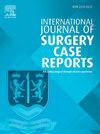Prosthetic rehabilitation of a hemimaxillectomy patient using a zygomatic - Corticobasal® implant- supported reconstructive prosthesis: A case report
IF 0.6
Q4 SURGERY
引用次数: 0
Abstract
Introduction
Rehabilitation of patients with hemimaxillectomy presents a challenge. This case report describes the successful use of zygomatic Corticobasal® implant- supported reconstructed prosthesis.
Clinical case presentation
A 20-year-old female patient presented to the clinic following hemimaxillectomy with soft tissue approximation one year ago. The patient was very depressed and reported high aesthetic concern and masticatory inefficiency and required a fixed prosthesis. A multidisciplinary team was formed. A panorama and cone beam CT were acquired. The treatment plan included the construction of an immediately loaded, fixed implant-supported reconstructive prosthesis using 6 Corticobasal® implant (BCS® and ZDI® implant designs, Dr. Ihde Dental AG, Switzerland) and a follow up program. After 3 years in function, the patient presented with 100 % implant survival rate, no complaints, and reported great improvement in esthetics, speech, mastication, and quality of life.
Discussion
The use of zygomatic Corticobasal® implants in this case provides the significant advantages of improving the prosthesis support and the utilization of the strongest zygomatic bone for implant anchorage. Moreover, the use of a metal framework for implant splinting and the monoblock design of the implant reduce the risk of implant/prosthesis overloading, and eliminate the biomechanical complication. Furthermore, the provided fixed prosthesis matched the patient's desire and significantly optimized the patient satisfaction and quality of life.
Conclusion
Within the limitation of the study, Corticobasal® implants can be used for rehabilitating hemimaxillectomy patients with optimum peri-implant soft tissue results, reducing risk of infection, achieving high survival rate and significantly improving the patient's aesthetic, functional, and satisfaction.
半上颌切除术患者使用颧-皮质基底®种植体支持重建假体的修复:1例报告。
引言:半上颌切除术患者的康复是一个挑战。本病例报告描述了颧皮质基底®种植体支持重建假体的成功应用。临床病例介绍:一名20岁的女性患者在一年前进行了半上颌切除术并进行了软组织近似手术。患者非常沮丧,并报告审美高度关注和咀嚼效率低下,需要固定假体。一个多学科小组成立了。获得全景和锥束CT。治疗计划包括使用6个Corticobasal®种植体(BCS®和ZDI®种植体设计,Dr. Ihde Dental AG,瑞士)构建立即加载的固定种植体支持重建假体和随访计划。功能恢复3年后,患者的种植体成活率为100%,无投诉,美观、言语、咀嚼和生活质量均有很大改善。讨论:在这种情况下,使用颧皮质基底®种植体提供了显著的优势,改善了假体的支持,并利用最强的颧骨进行种植体锚固。此外,金属框架用于种植体夹板和种植体的单块设计减少了种植体/假体超载的风险,并消除了生物力学并发症。此外,所提供的固定假体符合患者的愿望,显著提高了患者的满意度和生活质量。结论:在研究范围内,皮质基底®种植体可用于半上颌切除术患者的康复,种植体周围软组织效果最佳,感染风险降低,生存率高,显著改善患者的美观、功能和满意度。
本文章由计算机程序翻译,如有差异,请以英文原文为准。
求助全文
约1分钟内获得全文
求助全文
来源期刊
CiteScore
1.10
自引率
0.00%
发文量
1116
审稿时长
46 days

 求助内容:
求助内容: 应助结果提醒方式:
应助结果提醒方式:


